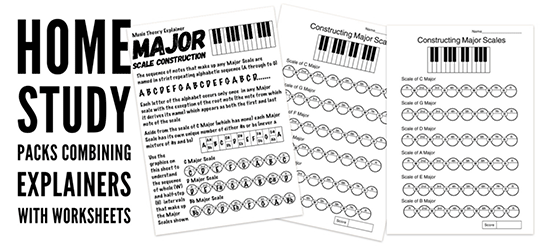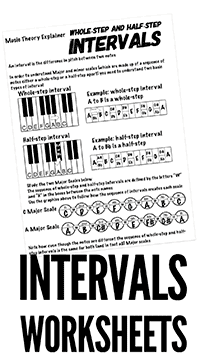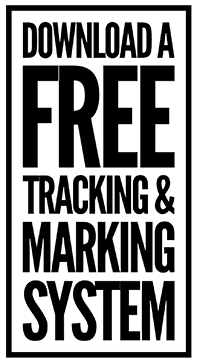A Complete Classroom and/or Online Music Theory Course
Upload to your school's IT system so that your students can study and revise classroom materials at home
The Learning Packs are an entire and complete Basic Music Theory Course!
The twelve packs combine to make up a course designed to take students from a place where they know absolutely nothing at all about the subject to a position where they fully understand the essential elements of music theory
No knowledge of notation required!
Note Names, Intervals, Scales, Chords and Keys The material is sequenced and designed so that they can achieve all of this without having to use or understand notated music at all
Ready Made Homework Materials!
What follows is a more detailed look at the materials to be in the learning packs (each learning pack is presented as a single "ready to use" multi-page PDF document)
Classroom activities can be supported by online home study if required

Music Theory Learning Pack 1
Note Names: 1
Download the free explainer PDF shown above
The classroom and/or online learning packs in action....
The explainer and three worksheets! (one covering the white notes and the other two featuring both white and black notes) The simplest possible start to a study of music theory. it is important to communicate to your students that during this very early stage they will need to have access to the explainers in order to build and reinforce knowledge and capabilities but that they are working towards a situation where they will be familir with music theory without having to look things up on paper or online
When working with the first two (note naming) learning packs you can provide your students with a series of note naming worksheets and ask that they work toward being able to complete them without reference to the explainer or other graphic aids. Let them know that they are aiming for a situation where they can find the note of C without looking at the handout and then becoming able to work out every other note name from there. Knowledge is no good if it stays on the paper!
The Download also contains Answer Sheets for all of the worksheets in the 12 packs so that you as a teacher can control the marking process
You can choose between making them available for student download or working through the material during classroom sessions according to your own individual needs and circumstances

There are loads of free lesson plans and worksheets on this site The free materials are just that! Completely free I dont want your email address which is what normally happens whenever press a link to free stuff I am not interested in chasing you around the internet with emails designed to part you from your money
I give the freebies away in the hope that you like them enough to buy the download (which is way less than the price of a single standard text book) but you don't have to You are quite welcome to take all of the free stuff and use it with my blessing
$18.00

The paid for download also contains (in a separate PDF document) answer sheets to all of the material featured in the twelve learning packs
Music Theory Learning Pack 2
Note Names (ctd)
A second set of materials (the explainer again and two additional worksheets) that will reinforce the knowledge gained from the last pack. The relevant "explainer" sheets are included again so that online or distance learners do not have to switch between documents when setting out to complete the worksheets
Above you can see a close up detail of one of the worksheets in this second music theory learning pack Students are required to work towards being able to put the correct letter name into the circles without access to the "explainer" handout
as with the first set of worksheets the process is.....
Locate a "C" note by focussing on the white key immediately to the left of any set of two black keys
Work out the note specified on the worksheet by moving up through the white keys assigning a name to each key in accordance with strict alphabetic sequence C D E F G A B and back to C
This material will allow learners to progress confidently to the next stage where the whole-step and half-step intervals that will facilitate Major and minor scale construction will be discussed

Music Theory Learning Pack 3
Whole and Half Step Intervals: 1
Download This complete learning pack FREE!
An "Explainer" and two worksheets themed around developing an understanding of the whole and half-step intervals that combine to make Major and minor scales. If you take a closer look at the worksheets you will notice that they utilise and then build upon the work already done on the subject of note naming. Learners are required to name a given note and are then tasked with providing the name (or choice of names) given to new notes a whole-step or a half-step above or below the one originally identified.
A feature of these packs (and indeed of the resources in general) is that they build upon the knowledge and capabilities developed during the study of materials encountered earlier in the programme
Click To Download The Above Pack FREE Now
Download everything that you see on this website for only $18.00
All of our Music Teacher's Resources to use for the rest of your life.
A "one click download" and for a single (and inexpensive) "one off" payment. Less expensive than a single copy of a paper based textbook with the advantage that you can print, send or upload our materials with a single click (you can't do that with a book?)
$18.00
More than 400 PDFs that effectively cover the "nuts and bolts" of music theory Resources that you can use year after year as the bedrock of your music theory teaching
I came up with these resources because I could not find them in one place anywhere else They are so cheap because I do not work for large education publishers who are more interested in selling paper based "drip fed" graded materials or online courses at a high mark up
This is the stuff that I needed to make sure that my students understood how music works!
This is the stuff that I needed to make sure that my students understood how music works!
$18.00

Music Theory Learning Pack 4
Intervals: 2
The "Explainer" document again and more worksheets that will help to make sure that students develop the understanding of whole and half-step intervals so that they can go on to become able to construct the Major (and minor) scales that are constructed by following a sequence of notes made up of those intervals

Music Theory Learning Pack 5
Major Scales: 1
Now that they understand note naming and whole and half-step intervals it is time to put that knowledge to good use by looking at the sequence of those intervals involved in constructing any Major Scale. I am constantly irritated by the way that exam boards "drip feed" Major and minor scales through their grades with "easy" scales (such as C and G Major) featuring in the early grades and other keys featuring more sharps or flats being encountered later. If our students can count up to twelve and know the alphabet from A to G they have the tools to know (or more importantly, to be able to work out for themselves) the notes contained within any Major or minor scale irrespective of how many sharp or flat notes are contained within them

Music Theory Learning Pack 6
Major Scales: 2
A second set of worksheets to help students to understand this most important musical concept. The idea is that the earlier pack makes them "aware" of how major scales work and this follow up material makes them "familiar" with how scales are constructed and work.

Music Theory Learning Pack 7
Minor Scales: 1
Now that they have developed an understanding of how all Major Scales are constructed from the same sequence of whole and half-step intervals it is time to use the same principles in order to have learners understand minor scales. When they have familiarised themselves with the theory and methodology involved in the construction of Major and minor scales they have the knowledge at their disposal to understand Major and minor chords which is the subject of the next learning pack

Music Theory Learning Pack 8
Triads: 1
Two "explainers" themed around helping students to understand the differences (and similarities) to be found in Major and minor chord types. The explainers show how if you know (or have developed a methodology which will allow you to work out)the notes of any Major or minor scale then you have tools to identify the notes in any Major or minor chord

Music Theory Learning Pack 9
Triads: 2
Two more worksheets and an "explainer" The worksheets invite students to differentiate between Major and minor triads designed to increase a learner's familiarity with the concepts and principles encountered to this point

Music Theory Learning Pack 10
Diatonic Harmony: 1
The last three packs deal with the subject of how chords work within keys
The first of these packs features a document explaining the principles of diatonic harmony (the series of Major and minor chords that can be constructed from the notes of any "parent" Major Scale) alongside two worksheets looking at the chords that can be found within particular keys. The three packs feature worksheets that each contain chords made up (only) of the notes that can be found within a single Major scale. Students are required to identify the chords and then having done that they have the task of identifying the Major key to which all of the chords belong

Music Theory Learning Pack 11
Diatonic harmony: 2
The "explainer" again along with three more worksheets. "Diatonic Puzzles" that invite learners to identify first a series of chords and then the keys to which the chords belong

Music Theory Learning Pack 12
Diatonic Harmony: 3
A final pack that (again) has the "explainer" alongside four more diatonic puzzles which require students to identify (first) a series of chords and (then) the key to which the chords belong
Download EVERYTHING that you see on this website for a "one off" payment of only $18.00
Less than the price of a single paper based textbook (and you can't print or electronically transfer/upload the pages of a textbook with the click of a button)
$18.00

The situation with regard to distance learning is different not only depending on where in the world you operate but even within a single country, state, district or county there is still huge variations with regard to the technology that any given school (and more importantly the students, when they are not able to be there for whatever reason) has available to them

Because of the simplicity of the resources on this site (they are really just a whole load of PDF documents) the "explainers" and worksheets can be used in learning packs that target students "weak areas" with regard to their understanding of key concepts such as Note Naming or Scale construction etc
A simple way to find out where your students may have "fallen off the bus" with regard to their functional knowledge of music theory is to use one of our simple one page Music Theory "Mini Exams" (there are twenty of these in the download). Ask your learner to complete a test and return it to you by means of whatever technology is available (email, school portal, PDF or even a photograph of their completed paper). Another option is to use the "diagnostic tool" that is part of the free student results tracking system featured later in this page

How do we know if our teaching is working?
"Teaching without learning is just talking" and if we adapt that old saying to factor in the emergence of new technologies it is fair to say that online teaching without learning is just a bunch of file exchanges. If we are going to do this online thing then we had better be sure that it will have an effect not least because the administrators who currently oversee what we do will have some forms to fill in about it.
You can download a free "Diagnostic Test and Tracking System" below that will allow you to record your students capability at the beginning and end of a period of online study
What did they know before we started? and What do they know now?
The answers to the questions above are central to the effectiveness of what we do as educators. The diagnostic and tracking system gets to the core of how we can demonstrate (to ourselves, our students and those who administrate us) the effectiveness of what we do

Some of our Music Theory Distance Learning Packs
The distance learning packs use a combination of the "Explainers" and worksheets designed to back up the knowledge and principles contained within them
What You Can Do With The Resources
Upload worksheets and handouts etc to a school system for students to download and work on at home
Email (or "snail mail") worksheets to your students
Compile worksheets into "home study packs" to be printed/downloaded
What You Can't Do
Sell them or give them away to the public
Put them (or videos or presentations using them) up on a public website/app etc
So long as you use them to help educate individuals that you know and actually have responsibility for teaching (your students at school/college or your private music/instrumental students) you can adapt the PDF's in accordance with your working methods and the technology available to you and your students
We provide the simplest of resources (PDFs) that can be adapted to suit just about all circumstances from "snail mail" or email to being uploaded onto a school or college system or newsletter to provide students with remote access to first class music theory materials that are proven to work. We also offer a free tracking system to prove (to ourselves, our students and our administrators) that what we are doing is making a real difference
Define and target each individual student's areas of weakness
The resources on this website allow music teachers to reliably assess what students already know before enacting a plan designed to ensure that they end up knowing more
$18.00
Our "one click" download consists of over 400 professionally prepared handouts that can be printed over and over again for less than the price of a single paper textbook! many of which deal with the correct identification of intervals
These resources are especially designed to make life easier for classroom music or instrumental teachers who need to get theoretical ideas over to students.
The handouts have been put together so that the same basic ground can be covered with differing levels of graphic support (some handouts feature keyboards and have space for letter names while others aimed at more advanced students rely on a more conventional musical stave approach).
They are designed so that a single music educator might work with all ability levels within a single session. challenging the more able learners whilst supporting those who are not so familiar with the concepts and material under study
DOWNLOAD more than 400 PDF's NOW!
Everything that you see on this website for a single one off payment of $18.00
A lifetime of re-usable resources that really work
$18.00
How to access your simple "one click" download
Buy your music teaching resources in complete safety via any major credit card (through paypal) or directly through your paypal account if you have one. If you choose to use a credit card, rest assured that we never see your credit card details as paypal do all of that for us.
When Paypal receive your payment you will be immediately invited to click a
"RETURN TO MERCHANT"button.
You will be taken to a page from where you can download the products that you have paid for NOW!
In the (rare) event that something should go wrong with the order/download process just email me at robh@teachwombat.com
I will check the order and send you the links that will get you to your stuff.
Cheers! Rob!

















